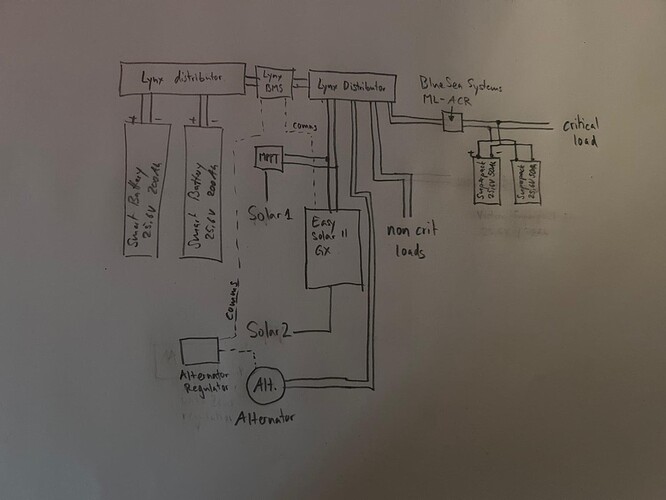Hello Victron community
I am seeking some inputs, help and clarification regarding lithium battery charging for the new energy system on my sailboat.
I am replacing the old and very little electric system to transform a day cruiser to a long distance offshore sailboat.
I am installing 2x Lithium banks. One for the main house loads and one as a backup for critical (navigation) equipment. The main house bank are 2x LFP Smart 25,6/200-a batteries with a Lynx BMS 500 wich connects them to another Lynx distributor. From this distributor the normal load and the critical loads are separately supplied. The critical loads are connected to the Lynx system via an ‘Automatic Charging Relais’ (BlueSea) and another battery bank of 2x parallel 25.6V 50Ah LiFePO4 Superpack (internal BMS). If the main battery bank fails and there is no charge from Solar panels or alternator., the automatic charging relay will disconnect and the normal load can not drain the navigation load battery bank which in this set up still supplies power to the critical loads. It seems to me to be a good system with redundancy if the main house battery fail and I have seen this done with AGM batteries. Otherwise if the Lynx BMS has an issue and disconnects the Smart batteries, the full boat would be blacked out. The Superpack batteries are a back up for critical navigation loads and could get the boat back to a port. I thought the Superpacks are a slim option with integrated BMS which don’t need another Lynx BMS or other external BMS systems. There is also an Victron EasySolar II GX inverter/charger unit installed, an extra MPPT and a regulated ‘high output alternator’.
Now comes the actual question where my knowledge leaks and I would like to have some opinions:
With the Smart battery/Lynx BMS and the LiFePO4 Superpacks I have two battery systems which are connected via a Automatic Charging Relay in normal operation. Is it possible two charge both battery banks of different kind and maybe different state of charges with one charging source (Easy Solar charging or Zeus regulated alternator)? How good is this for the batteries when one bank requires ‘bulk’ charge and the other ‘float’. Victron seems to make a big story of five or even 7-stage adaptive charging algorithm and I am worried that the batteries would take damage when they require different charging states at the same time. I believe the Lynx BMS dictates to the EasySolar what charging he requires for the Smart batteries but would this also work for the Superpack batteries? Do I just need to make sure both battery banks have the same charge when taking the system in use? I am not sure if I make a too big story out of this? (If so I am sorry ![]() )
)
I do have already the Smart batteries, Lynx system and the EasySolar II GX. So I could still get another navigation battery system if Victron Superpack LiFePO4 don’t work.
Thank you for your supports and inputs.
Roman
